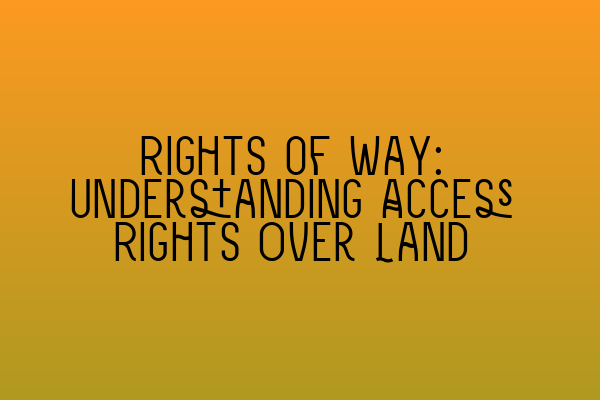Rights of Way: Understanding Access Rights Over Land
As a property owner or buyer, it is crucial to have a clear understanding of the rights of way associated with a piece of land. Establishing and understanding access rights over land is essential for both residential and commercial property transactions. In this blog post, we will delve into the intricacies of rights of way and provide you with a comprehensive guide to understanding access rights over land.
What are Rights of Way?
Rights of way refer to the legal right to pass through or use a specific route or pathway that belongs to another person or entity. These rights can be granted to individuals, neighboring properties, or even the general public. Rights of way can be crucial for accessing a property, especially when there is no direct access from a public road.
Understanding Easements
Rights of way are commonly referred to as easements. An easement is a legal right that allows someone to use another person’s land for a specific purpose. It is important to note that an easement does not provide ownership of the land; rather, it grants a limited right to use the land.
Types of Rights of Way
There are several types of rights of way that you may encounter during a property transaction. Here are some of the most common ones:
1. Public Rights of Way: These rights are available to the general public and allow access to specific routes, such as footpaths, bridleways, and byways. Public rights of way are usually established and maintained by the local authorities.
2. Private Rights of Way: Private rights of way are granted to specific individuals or properties. These rights are usually documented in legal agreements, such as deeds or contracts. Private rights of way can be essential for accessing properties that are not directly connected to a public road.
3. Prescriptive Rights of Way: Prescriptive rights of way are acquired through long-term use of a particular route without formal permission. For example, if a property owner has been using a pathway across a neighboring property for a significant period, they may acquire a prescriptive right of way.
Establishing Rights of Way
To establish rights of way, it is essential to examine the legal documentation associated with the property. These documents may include title deeds, contracts, and any agreements that outline the rights and restrictions related to the land. It is advisable to engage the services of a qualified property solicitor to conduct a thorough investigation of these documents to ensure that all rights of way are identified and properly understood.
Resolving Disputes
In some cases, disputes may arise concerning rights of way, leading to potential legal conflicts. If a dispute arises, it is crucial to seek legal advice from a property solicitor experienced in handling rights of way issues. They can assist in resolving the dispute through negotiation, mediation, or, if necessary, court proceedings. Resolving disputes related to rights of way ensures that the rights of all parties involved are protected.
Conclusion
Understanding access rights over land is pivotal for any property owner or buyer. Whether you are purchasing a property or dealing with an existing property, having a clear understanding of rights of way is crucial. By knowing the different types of rights of way, establishing them correctly, and knowing how to resolve any potential disputes, you can ensure a smooth and hassle-free property transaction.
For more information on property law and preparing for SQE exams, check out our related articles:
– SQE 1 Practice Exam Questions
– SQE 1 Practice Mocks FLK1 FLK2
– SQE 2 Preparation Courses
– SQE 1 Preparation Courses
– SRA SQE Exam Dates
At SQE Property Law & Land Law, we specialize in providing expert legal advice and assistance for all your property-related matters. Contact us today to ensure a smooth and successful property transaction.
